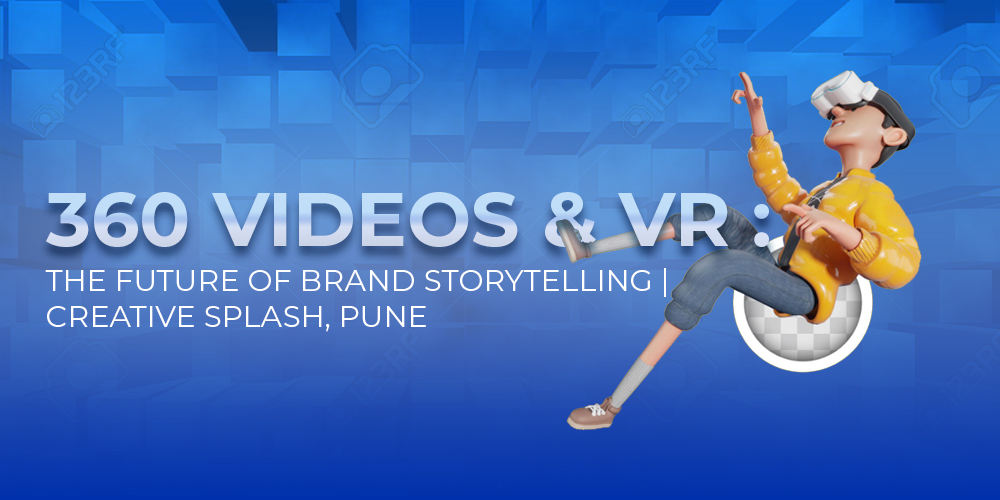360° Videos & VR: The Future of Brand Storytelling | Creative Splash, Pune
360° Videos & VR: The Future of Brand Storytelling | Creative Splash, Pune

The way brands tell their stories is evolving at lightning speed. What started with print ads and TV spots has been utterly transformed by digital marketing and video production. Now, immersive formats like 360° videos, virtual reality (VR), and 3D animation are redefining how companies capture audience attention and build emotional bonds.
These technologies are not just trends — they are shaping the very future of brand storytelling and digital experiences.
The Rise of Immersive Storytelling
Traditional video gives viewers a single viewpoint: you sit back and watch. With 360° video production, you become part of the scene. You can explore in every direction — just by dragging with your mouse, swiping on your phone, or tilting your head in a VR headset.
Instead of telling you a story, brands let you experience it — making the narrative more interactive, personal, and unforgettable.
Why 360° Experiences Drive Deeper Engagement
There’s a good reason brands are pouring resources into these formats — humans crave experiences, not just information.
With 360° video storytelling:
- Viewers choose what angle or detail to explore, taking control of their journey through the story.
- The more senses and emotions are involved, the more memorable that experience becomes.
- People are much more likely to share immersive videos, boosting organic reach and social media engagement.
Examples like National Geographic’s virtual expeditions or IKEA’s virtual showrooms invite you to step inside their world, fostering deep emotional engagement and brand loyalty.
How Virtual Reality (VR) Transforms Brand Connection
While 360° video is powerful on its own, VR takes immersion to another level. Strapping on a headset like Apple Vision Pro or Meta Quest makes you feel like you are truly “there” — whether in a rainforest, a city, or a recreated brand environment.
Brands using VR can:
- Guide users through product demos, showrooms, or virtual brand experiences.
- Harness spatial audio, interactivity, and even simulated touch for greater immersion.
- Inspire empathy, trust, and emotional connection far beyond what’s possible on a flat screen.
Real-World Applications and Success Stories
Across industries, brands are leveraging 360° video and VR production to connect with customers:
- National Geographic invites viewers to explore the Amazon in 360°, letting you see, hear, and feel the rainforest.
- IKEA allows customers to virtually try out furniture, simplifying complex buying decisions.
- Häagen-Dazs uses VR to place viewers inside a honeybee colony, connecting sustainability with brand purpose.
These examples show how immersive media brings audiences closer to the heart of a brand story — and why every brand should consider VR marketing or 360° video content creation as part of its digital strategy.
The Benefits: Why Brands Shouldn’t Wait
- Stronger Emotional Connections: Immersive stories inspire feelings and memories, not just awareness.
- Better Retention: Audiences are more likely to remember and act on experiences they’ve lived firsthand.
- Boosted Conversions: Realistic walkthroughs and interactive demos nudge viewers from interest to purchase.
- Viral Potential: Novelty and engagement drive sharing across YouTube, Instagram, and Facebook.
At Creative Splash Animation Studio Pune, we help brands translate these benefits into measurable marketing results.
Overcoming the Challenges
Like any technology, 360° video and VR production come with hurdles:
- Production Costs: High-quality immersive content requires skilled animators and specialized cameras.
- Audience Education: Not everyone knows how to navigate 360° or VR formats — guidance is key.
- Technical Limitations: File sizes, post-production workflows, and platform compatibility can be challenges.
Best Practices for Brands Entering the Space
- Plan Your Narrative: Build an experience with a clear story arc and emotional focus.
- Invest in Quality: Use professional-grade cameras, lighting, and editing for a seamless finish.
- Test Across Devices: Ensure content performs well on mobile, desktop, and headsets.
- Guide the Viewer: Use audio prompts, motion cues, or interactive hotspots for easy navigation.
The Road Ahead
As hardware becomes more affordable and audiences become more tech-savvy, immersive storytelling will evolve even further. Expect multi-user VR events, AI-driven interactive narratives, and personalized 360° ads that adapt to user behavior.
Brands that embrace this shift now will forge deeper relationships with tomorrow’s consumers — those who don’t just want to watch stories, but want to step inside them.
Our Expertise & Commitment
Search
Categories
Get A Free Quote
Recent Posts
- 360° Videos & VR: The Future of Brand Storytelling | Creative Splash, Pune
- Color Grading vs Color Correction – What’s the Difference?
- AI-Generated Graphics vs Human Designers – Who Wins?
- Stop Guessing: MP4, MOV, or GIF? The Best Video Format for Skyrocketing Your Social Media Ad Conversions
- Why Short-Form Videos Convert Better in Ads ?

